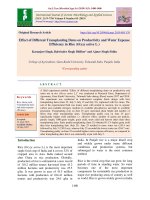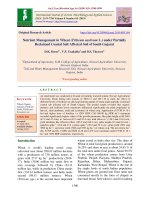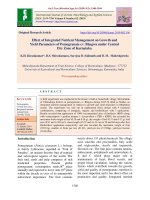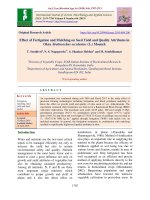Effect of different age of rootstocks on success of softwood grafting technique in tamarind (Tamarindus indica L.) under northern Dry Zone of Karnataka
Bạn đang xem bản rút gọn của tài liệu. Xem và tải ngay bản đầy đủ của tài liệu tại đây (263.23 KB, 5 trang )
Int.J.Curr.Microbiol.App.Sci (2019) 8(4): 562-566
International Journal of Current Microbiology and Applied Sciences
ISSN: 2319-7706 Volume 8 Number 04 (2019)
Journal homepage:
Original Research Article
/>
Effect of Different Age of Rootstocks on Success of Softwood Grafting
Technique in Tamarind (Tamarindus indica L.) under Northern
Dry Zone of Karnataka
Arif A. Agasimani1*, G. S. K. Swamy2, Nagesha Naik3, R.C. Jagadeesha4,
P.M. Gangadharappa5 and N. Thammaiah6
1
Department of Horticulture, Lalbagh, Bengaluru – 560 004, Karnataka, India
2
Department of Fruit Science, COH, Mysuru, Karnataka, India
3
K. R. C. College of Horticulture, Arabhavi – 591 218, Karnataka, India
4
UHS, Bagalkot – 587 104, Karnataka, India
5
College of Horticulture, Munirabad, Karnataka, India
6
Department of HPP, COH, Mysuru, Karnataka, India
*Corresponding author
ABSTRACT
Keywords
Tamarind
(Tamarindus
indica L.), DAG,
Per cent Sprouting
Article Info
Accepted:
07 March 2019
Available Online:
10 April 2019
An experiment was conducted on effect of different age of rootstocks on success
of softwood grafting in tamarind. Higher percentage of graft success (70.39%),
grafts survivability (70.95%), sprouting per cent (14.40%), minimum days taken
for sprouting (12.52) and number of sprouts (7.23) were noticed in T 7 (6 month
old rootstocks). The maximum graft height (37.31 cm), graft diameter (7.92 mm),
length of sprouts (19.02 cm) and number of leaves (41.35) were noticed in T 7.
Study revealed that, softwood grafting in April and May on 6 month old
rootstocks might be followed for multiplication of elite tamarind trees with high
graft success.
1979). India exports processed tamarind pulp
to western countries mainly European and
Arab countries and more recently the USA
(Rao and Mathew, 2012). It is estimated that
India produces an annual production of pulp
over 1.99 lakh tones and exported the
tamarind products worth of rupees 57 crores
per annum during 2017-18 (Anon., 2017). It
Introduction
Tamarind (Tamarindus indica L.) is a
monotypic genus tree belonging to the family
Leguminosae, sub-family caesalpiniaceae
with somatic chromosome number of 2n=24
(Purseglove et al., 1987). It is indigenous to
Tropical Africa and Southern India (Nas,
562
Int.J.Curr.Microbiol.App.Sci (2019) 8(4): 562-566
is highly heterozygous, cross-pollinated fruit
crop and as such seedlings exhibit a wide
range of variations, which aids in the
selection of the superior desirable genotypes.
Due to cross pollination and predominant
practice of seed propagation, there is immense
opportunity to locate elite trees having
desirable horticultural traits, which needs to
be conserved and exploited (Keskar et al.,
1989; Pathak et al.,1992; Karale et al., 1999).
Despite its varied advantages, it could not
attract suitable scientific attention towards its
propagation. True-to-the-type propagules
could be multiplied from elite trees that
produce good quality fruits only by asexual
methods. Of various propagation methods,
grafting is of paramount importance in
tropical and subtropical fruit trees as they
result in high success and field establishment.
Therefore, the present investigation was
undertaken to study the effect of different age
of rootstock on success of softwood grafting
under Northern dry zone of Karnataka.
number of sprouts, sprouting per cent were
recorded soon after bud burst while success
per cent and survivability of grafts were
recorded 3 months after grafting. Graft height
(cm), graft diameter (mm), sprout length (cm)
and number of leaves were recorded at an
interval of 30, 60 and 90 days after grafting.
Results and Discussion
The perusal of the data presented in Table 1
reveals that days required for bud sprouting
differed significantly due to different aged
rootstocks used for softwood grafting. It was
observed that the T7 (6 months) took
significantly minimum number of days for
sprouts (12.52), maximum number of sprouts
(7.23) and sprouting percentage (14.40%).
Higher temperature during March-April has
helped in early sprouting which may be due to
fast establishment of vascular connection in
rootstock and scion as has been reported by
Satishkumar (2001), Ganachary (2005),
Veeresh (2006), Giri and Lenka (2007), Singh
and Singh (2007). The success in bud
sprouting was affected significantly by time
of propagation (Table 1 and 2). The highest
sprouting was recorded when softwood
grafting was done in March and April month,
closely followed by May. Least sprouting was
recorded in T12 (1 month). Similarly, per cent
success also showed significant variation
when grafting was done on April month. This
finding is in agreement with the findings of
Purushotham and Narasimharao (1990),
Shinde et al., (1996), Satisha et al., (1997),
Kulwal et al., (1997), Nachegouda (1997),
Bodkhe and Lalan (2010), Bharad and
Mahorkar (2011). The best results in
sprouting and success in March, April and
May month may be due to optimum
temperature and relative humidity prevailing
during this period resulting in early contact of
cambium layers of stock and scion, early
callus formation and initiation of subsequent
growth.
Materials and Methods
The investigation was carried out at K. R. C.
College of Horticulture, Arabhavi, Karnataka,
India during the year 2018. The locally
available seeds of tamarind (Belagavi region)
were sown in the polythene bags filled with
sand, soil and FYM (1:1:1) for raising the
rootstocks. Irrigation, weeding and other
desired intercultural operations were done as
and when required. About 1-12 months old
seedlings of uniform size having stem of
pencil thickness were used as rootstock.
Softwood grafting was carried out at March
and April month of 2018 and data were
recorded. Scion shoots of promising genotype
(DTS-2) having desirable horticultural traits
was used to perform the grafting. The
experiment was laid out in completely
randomized block design with three
replications and 10 plants in each replication
as unit. Data on days taken for sprouting,
563
Int.J.Curr.Microbiol.App.Sci (2019) 8(4): 562-566
Table.1 Effect of age of rootstock on percent graft success, sprouting percentage, days taken for sprouting, number of sprouts, graft
height, graft diameter, sprout length and number of leaves in softwood grafting of tamarind during 2018
Treatment Age of
Per Sprouting Days Number
Graft height
Graft diameter
Sprout length
Number of leaves
rootstock cent percentage taken for
of
(cm)
(mm)
(cm)
graft
sprouting sprouts 30
60
90
30
60
90
30
60
90
30
60
90
success
DAG DAG DAG DAG DAG DAG DAG DAG DAG DAG DAG DAG
12 months 33.43
6.66
14.35
3.33 5.10 19.69 24.71 2.06 3.50 4.31 2.51 6.62 10.93 3.94 24.00 31.20
T1
11 months 28.40
12.67
15.26
6.23 6.06 19.26 22.11 2.11 3.56 3.80 2.07 5.88 10.69 2.74 15.28 29.53
T2
10
months
36.69
12.50
16.04
6.25 6.66 21.59 24.14 2.54 3.92 4.20 2.48 5.76 12.21 3.77 16.61 31.93
T3
9 months 29.06
9.47
17.55
4.77 8.44 22.81 27.89 3.65 5.27 5.48 2.25 6.62 14.37 3.43 19.67 33.04
T4
8 months 42.37
12.53
13.05
6.27 9.25 25.77 31.21 4.15 6.30 6.52 2.67 8.16 16.17 3.55 25.41 33.87
T5
7
months
60.31
12.53
12.73
6.30 11.18 29.09 32.37 5.14 7.16 7.32 2.79 8.33 18.47 4.74 34.04 37.47
T6
6 months 70.39
14.40
12.52
7.23 13.16 31.35 37.31 5.63 7.83 7.92 3.01 9.42 19.02 4.75 40.80 41.35
T7
5 months 69.48
13.20
19.70
6.67 7.02 25.38 32.48 4.11 6.54 6.79 1.86 6.68 14.66 3.41 27.40 29.30
T8
4 months 33.90
5.47
22.52
2.73 5.17 19.89 25.18 3.03 6.16 6.24 1.59 6.09 7.92 3.08 30.00 30.40
T9
3 months 30.59
4.80
22.91
2.40 4.76 15.97 18.71 2.13 5.78 6.19 1.68 4.99 6.05 2.74 18.71 22.33
T10
2 months 26.35
3.67
24.33
2.03 4.67 14.18 18.09 1.89 4.59 5.55 1.64 4.25 5.73 2.53 11.87 16.88
T11
1months 20.71
2.13
25.94
1.07 4.34 11.45 14.32 1.73 3.18 4.07 1.33 3.74 5.54 2.00 8.80 15.61
T12
Mean 40.14
9.14
18.07
4.61 7.15 21.37 25.71 3.18 5.32 5.70 2.16 6.38 11.81 3.39 22.72 29.41
S.Em± 1.31
0.60
0.41
0.28 0.35 0.58 0.82 0.29 0.17 0.17 0.19 0.45 0.50 0.30 1.72 1.03
CD
5.19
2.40
1.63
1.13 1.39 2.30 3.25 1.14 0.67 0.68 0.76 1.79 2.01 1.22 6.80 4.07
0.01
CV (%) 5.66
11.52
3.94
10.74 8.55 4.72 5.54 15.79 5.58 5.28 15.47 12.30 7.47 15.77 13.12 6.06
DAG – Days After Grafting
Month of grafting: April 2018
564
Int.J.Curr.Microbiol.App.Sci (2019) 8(4): 562-566
Table.2 Effect of age of rootstock on grafts survival in softwood grafting of tamarind genotypes
during 2018
Treatment
Age of rootstock
T1
T2
T3
T4
T5
T6
T7
T8
T9
T10
T11
T12
12 months
11 months
10 months
9 months
8 months
7 months
6 months
5 months
4 months
3 months
2 months
1 months
Mean
S.Em±
CD 0.01
CV (%)
At the final observation (90 Days after
grafting), the data revealed significant
variation in graft height (cm), graft diameter
(mm), length of sprout (cm) number of leaves
that ranged between 14.32 to 37.31 cm, 4.07
to 7.92 mm, 5.54 to 19.02 cm and 15.61 to
41.35, respectively (Table 1).
Graft survival (%)
2018
31.09
30.69
39.57
30.83
38.96
62.92
70.95
60.83
38.77
31.11
28.91
27.03
40.97
0.36
1.42
1.52
References
Anonymous, 2017, Area and production of
spices in India. Spices Board, Cochin,
Kerala.
Awasthi, O. P. and Shukla, N. 2003, Effect of
time on success of soft wood grafting in
tamarind (Tamarindus indica L.). Range
Mangt. Agro-forestry, 24: 31-34
Bharad, S. and Mahorkar, V., 2011, Softwood
grafting as useful method of
propagation
for
commercial
multiplication of Syzygium cuminii L.
under semi-arid climatic conditions of
India. Acta Hort., 890: 230-234.
Bodkhe, V. A. and Lalan, V. R., 2010,
Propagation studies in jamun. Int. J.
Agric. Sci., 6 (1): 250-252.
Ganachary, V., (2005), Evaluation and
propagation of tamarind genotypes.
M.Sc. (Hort.) Thesis, University of
Agricultural Sciences, Dharwad.
Giri, B. and Lenka, P. C., 2007, Propagation
Maximum graft height, length of sprouts,
diameter of grafts and number of leaves were
recorded in May month. The quick and strong
union formation, better nutrient uptake and
ample growing period might have caused
better plant growth and more number of
leaves per plant in April and May.
Awasthi and Shukla (2003), Giri and Lenka
(2007), Singh and Singh (2007) recorded
similar findings in tamarind under different
agro-climatic conditions. Therefore, softwood
grafting in April and May month may be
followed for multiplication of elite tamarind
trees with high graft success rate.
565
Int.J.Curr.Microbiol.App.Sci (2019) 8(4): 562-566
of tamarind (Tamarindus indica L.)
through softwood grafting. Indian
Forester, 18 (2): 1133-1135.
Karale, A. R., Wagh, A. P., Pawar, B. G. and
More, T. A. 1999, Association of fruit
characters in tamarind. J. Maharashtra
Agril. Univ. 24(3): 19-20.
Keskar, B. G., Karale, A. R., Dhawale, B. C.
and Chaudhary, K. G. 1989,
Improvement of tamarind by selection.
Maharashtra J. Hort. 4: 121-24.
Kulwal, U., Tayde, G. S., Chaudari, M. H.
and Verma, 1997, An easy method of
propagation of tamarind. Proceedings of
National Symposium on Tamarindus
indica L., Tirupathi, Andhra Pradesh,
27-28 June, 1997, pp. 94-97.
Nachegouda, V., 1997, Propagation of
tamarind by layering and greenwood
cleft grafting. Proceedings of National
Symposium on Tamarindus indica,
Tirupathi, Andhra Pradesh, 27-28 June,
1997, pp. 89-93.
Nas, S., 1979, In: Tropical Legumes:
Resources for the Future, Washington
DC, pp.117–121.
Pathak, R. K., Ojha, C. M. and Dwivedi, R.
1992, Adopt patch budding for quicker
multiplication in tamarind.
Purseglove, J. W. 1987, Tropical crops.
Dicotyledons, Longuma. Science and
Technology, pp. 204-206.
Purushotham, K. and Narasimharao, S. B. S.,
1990, Propagation of tamarind by
veneer and softwood grafting. South
Indian Horticulture, 38: 225.
Rao, Y. S. and Mathew, K. M., 2012,
Tamarind (Tamarindus indica L.).Wood
head publishing limited, England. pp,
512-533.
Satishkumar, V., 2001, Studies on wedge
grafting in tamarind (Tamarindus indica
L.). M. Sc. (Agri.) Thesis. University of
Agriculture Sciences, Dharwad.
Satisha, J., Melanta, K. R. and Venkatesha, J.,
1997, Effect of age of rootstock on
success of softwood grafting in
tamarind. Current Research, 26 (6-7):
93-94.
Singh, S. and Singh, A. K., 2007,
Standardization of method and time of
vegetative propagation in tamarind
under semi-arid environment of western
India. Indian. J. Hort., 64(1): 45-49.
Shinde, N. N., Ingle, G. N. and Shirurkar, D.
D., 1996, Softwood grafting in tamarind
(Tamarindus indica L.). Journal of
Applied Horticulture, 2(1): 139-142.
Veeresh, K., 2006, Evaluation, propagation
and
processing
of
tamarind
(Tamarindus indica L.). M.Sc. (Hort.)
Thesis, University of Agricultural
Sciences, Dharwad.
How to cite this article:
Arif A. Agasimani, G. S. K. Swamy, Nagesha Naik, R.C. Jagadeesha, P.M. Gangadharappa and
Thammaiah, N. 2019. Effect of Different Age of Rootstocks on Success of Softwood Grafting
Technique in Tamarind (Tamarindus indica L.) under Northern Dry Zone of Karnataka.
Int.J.Curr.Microbiol.App.Sci. 8(04): 562-566. doi: />
566









